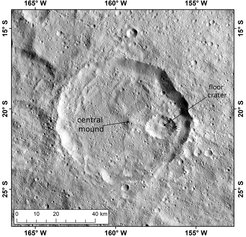Dwarf planet Ceres: Origin in the asteroid belt?
Bright yellow deposits in Consus Crater bear witness to dwarf planet Ceres' cryovolcanic past - and revive the debate about its place of origin.
Dwarf planet Ceres may have originated in the asteroid belt - and did not necessarily “migrate” there from the outer edge of the Solar System. This is indicated by bright, ammonium-rich deposits in Consus Crater, as a research team led by the Max Planck Institute for Solar System Research (MPS) in Göttingen argues today in the Journal of Geophysical Research Planets. The researchers analyzed observational data from NASA's Dawn space probe. Dawn had already discovered widespread ammonium deposits on the surface of Ceres years ago. According to some scientists, this suggests that frozen ammonium played a role in the dwarf planet’s formation. Ammonium is only stable in the outer Solar System. The new study finds another possibility: like other bright deposits on Ceres, the ammonium-rich material in Consus Crater could have been transported to the surface from within by Ceres' curious cryovolcanism.

Dwarf planet Ceres is an unusual “inhabitant” of the asteroid belt. With a diameter of around 960 kilometers, it is not only the largest body between the orbits of Mars and Jupiter; unlike its rather primitive “cohabitants”, it is also characterized by an extremely complex and varied geology. This points to an eventful past in which Ceres changed and developed over many billions of years. Data from NASA's Dawn space probe, which studied Ceres up close from 2015 to 2018, have provided evidence that Ceres was - and probably still is - the scene of unique cryovolcanism. Bright, whitish salt deposits can be found in several impact craters. Researchers believe they are the remnants of a brine that seeped to the surface from a liquid layer between the mantle and crust over many billions of years. Images and observational data from Consus Crater now analyzed by the research team in greater detail than ever before also show such bright material, albeit in part of a more yellowish color.
A crater within a crater
Conus Crater is located on Ceres’ southern hemisphere. With a diameter of around 64 kilometers, it is not one of the dwarf planet’s particularly large impact craters. Images taken by Dawn's scientific camera system, which was developed and built under the lead of the MPS, show a circumferential crater wall that rises about 4.5 kilometers above the crater floor and has partially eroded inwards. It encloses a smaller crater covering an area of about 15 kilometers by eleven kilometers that dominates the eastern half of Consus’ crater floor. The yellowish, bright material is found in isolated speckles exclusively on the edge of the smaller crater and in an area slightly to the east of it.
As the new analysis of data from the camera system and the VIR spectrometer suggests, the yellowish bright material in Consus Crater is rich in ammonium. In traces, the compound, which differs from ammonia by an additional hydrogen ion, is almost omnipresent on the surface of Ceres in the form of ammonium-rich minerals. In the past, scientists believed that these minerals could only have formed through contact with ammonium ice in the cold at the outer edge of the Solar System, where frozen ammonium is stable over long periods of time. In closer proximity to the Sun, it evaporates quickly. Ceres must therefore have formed at the edge of the Solar System and only later “relocated” to the asteroid belt, they inferred. The current study now shows for the first time a connection between ammonium and the salty brine from Ceres’ interior. The team argues that therefore the dwarf planet’s origin does not necessarily have to be in the outer Solar System. Ceres could also be truly native to the asteroid belt.
Ammonium from the depths

The researchers assume that the components of ammonium were already contained in Ceres’ original building blocks. As ammonium does not combine with the typical minerals in Ceres' mantle, it gradually accumulated in a thick layer of brine that extended globally between the dwarf planet's mantle and crust. Cryovolcanic activity caused the ammonium-rich brine to rise repeatedly over the course of billions of years, and the ammonium it contained gradually seeped into the large-scale phyllosilicates of Ceres' crust. Phyllosilicates, which are characterized by a layer-like crystal structure, are also widespread on Earth, for example in clayey soils. “The minerals in Ceres’ crust possibly absorbed the ammonium over many billions of years like a kind of sponge,” explains MPS scientist Dr. Andreas Nathues, first author of the current study and former Lead Investigator of Dawn’s camera team.
There is much to suggest that the concentration of ammonium is greater in deeper layers of the crust than near the surface. The few places on the surface of Ceres where conspicuous patches of the yellowish-bright material can be found outside Consus Crater are also located within deep craters. As the current study shows in detail, the impact that created the small eastern crater only 280 million years ago is likely to have exposed material from the deep, particularly ammonium-rich layers in Consus Crater. The yellowish-bright speckles to the east of the smaller crater are material that was ejected as a result of the impact.
“At 450 million years, Consus Crater is not particularly old by geological standards, but it is one of the oldest surviving structures on Ceres. Due to its deep excavation, it gives us access to processes that took place in the interior of Ceres over many billions of years - and is thus a kind of window into the dwarf planet's past,” says MPS researcher Dr. Ranjan Sarkar, a co-author of the study.













